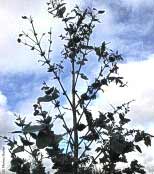|
|
|
Planting to Reduce the Impact of Pests

Creating Biodiversity to Attract Predators
By planting a selection of tree, shrub and grass species,
it is possible to create a wide range of different habitat
types on a property. This will help attract a wide range of
native birds, animals and insects, many of which may help
control the abundance of pests, especially insects, that can
affect trees and crops.
The key to encouraging predators is to provide suitable habitat.
While each type of predator or parasite has its own specific
habitat requirements, generally the more diverse the habitat
is, the more diverse and abundant predators will be. Extremes
in heat and low humidity disadvantage predatory and parasitic
insects, and it may be desirable to modify the environment
to favour these beneficial species.
Structural diversity is also an important micro-habitat feature.
Planting windbreaks and inter-row cover crops can create desirable
micro-habitats andcertain herbs and clovers can provide over-wintering
sites for predatory mites in orchards. Pollen-producing plants
can also encourage high populations of predatory mites. Nectar-producing
plants can provide a source of nourishment for some wasp parasites.
Siracid wasps in the New England Tablelands, which feed and
breed on Acacia windbreaks planted around paddocks, have been
shown to reduce the populations of scarab larvae in pastures.
These scarab larvae if allowed to develop may defoliate Eucalyptus
trees during their adult stage.
Farm forestry plantings could include a variety of indigenous
species, including shrubs.
.jpg)
Summer flowering species attract wasps that are parasites
of a variety of agricultural and forestry insect pests. Other
beneficial insects that parasite insect pests include robber
flies, lacewings, ladybirds, hover flies, mantids and bee-flies.
For example, bee-flies lay eggs in knot-holes and are effective
in controlling wingless grasshoppers.
Many mammals also control insect pests. For example, sugar
gliders feed on acacia gum and eucalypt sap in winter, while
in spring and summer they feed on insects including moths
and pasture scarab. Sugar gliders need trees with hollows
to live in, while insectivorous birds and bats use tree hollows
for roosting and nesting. Lizards feed on insects and live
amongst fallen timber and dead trees.
As many fauna depend upon dead timber, while others need to
live in trees with hollows and knot-holes, it is important
that both dead and hollow-bearing live trees are retained.
Many birds rely on eucalypt trees to survive and they also
require shrubs and grasses. Over 300 bird species live in
eucalypt forests. Trees, shrubs and grasses provide shelter,
nesting sites and food for birds, including nectar, seeds,
fruits and insects.
Birds feed on a wide range of insects including those that
feed on the leaves of eucalypts. Scarab beetles, leaf beetles,
caterpillars and a wide variety of sap sucking insects often
attack trees on farms. Isolated or scattered trees can be
severely damaged by insects because they usually don't support
bird populations. Densities of birds in some forests of roughly
20-30 birds per hectare can consume 250-500 grams of insects
per hectare per day.
Forestry may increase the presence of pests. As well as providing
habitat for native fauna, trees on farms can provide cover
for vertebrate pests such as foxes, cats, rabbits and hares.
Transferring areas from traditional agricultural activities
to plantation forestry may increase the presence of vertebrate
pests by providing protective cover for them and increases
the difficulty of mounting an efficient control program.
Back to top
|
